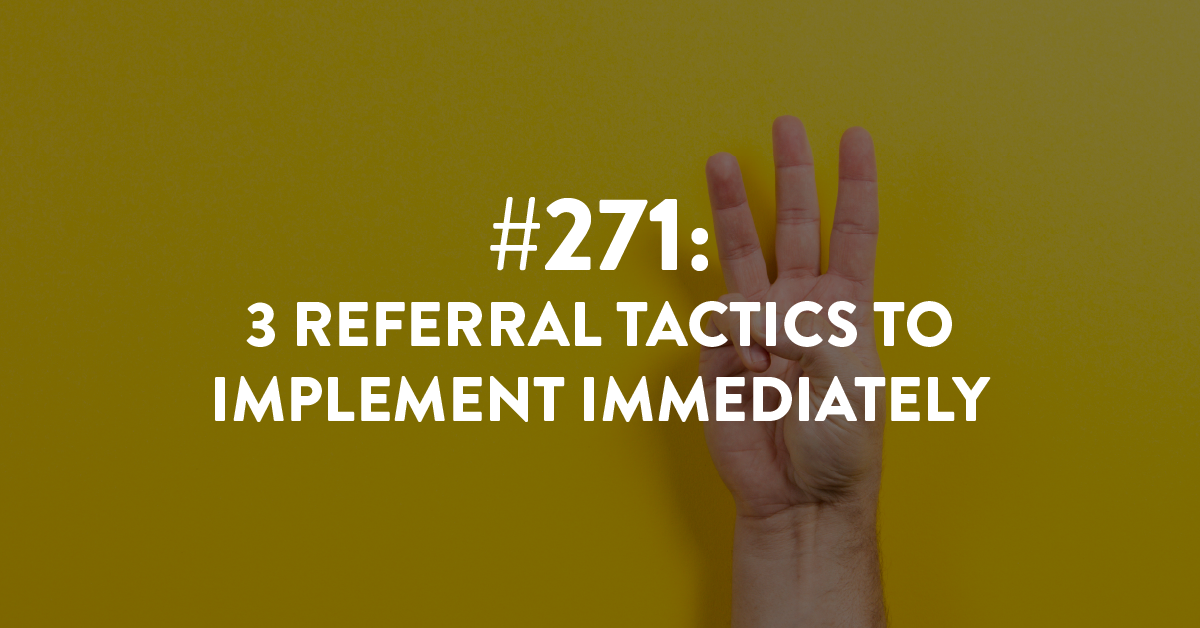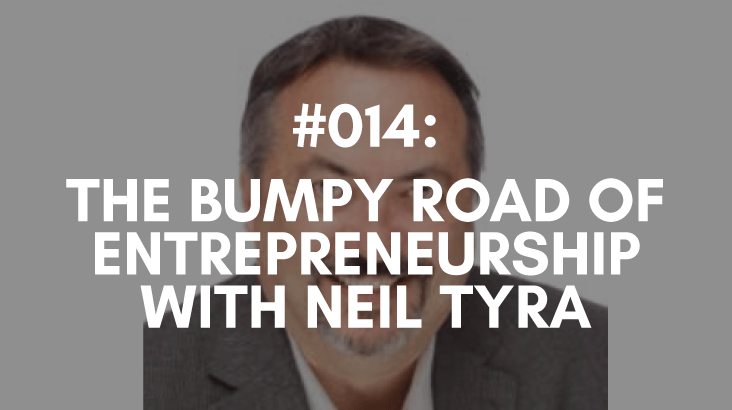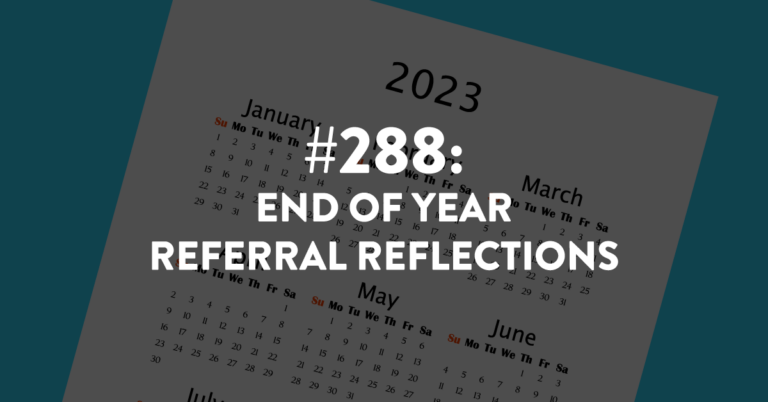Ep #271: 3 Referral Tactics to Implement Immediately
Implementation trumps knowledge every day—and twice on Sunday! Because what good is all that knowledge and information if you don’t implement it? So if you want to get better at implementation and put all that knowledge you’ve gathered to good use, I’ve got you covered today.
Listen in as I share a few simple and clear tactics that you can start implementing right away. Generating referrals naturally and consistently is key to growing your business smoothly, and using the right information is what’s going to move that needle for you and allow you to get the referrals that your business needs. So grab a notebook, and get ready to put these tips to good use!
Links Mentioned During the Episode:
Download our Referral Goal Calculation worksheet.
Access our Thank You Card Script.
Need help determining your low-hanging fruit referral strategy? We teach is in inside Summer School for Referrals program.
Submit your application to join us inside Building a Referable Business™ coaching program.
Next Episode:
Next episode is #272, and we’re doing a 10-year look back. This one’s going to be fun!
Download The Full Episode Transcript
Read the Transcript Below:
Stacey Brown Randall: Implementation trumps knowledge every day and twice on Sunday. So, let’s give you some referral tactics to start implementing right now.
Hey there, and welcome to episode 271 of the Roadmap to Referrals Podcast, a show about helping you build a referable business. I’m your host, Stacey Brown Randall.
My journey from a business failure to a successful business, now 10 years in, I know generating referrals naturally and consistently has made all the difference. Working with clients around the world, we leverage the science of referrals, protect relationships above all else, and help you build a referral business.
So, maybe you’ve heard the quote, “Implementation is worth far more than information.” Or said another way, “Implementation trumps knowledge every day and twice on Sunday.” I like that second one so much, I actually started each of my summer school classes with that statement — “Implementation trumps knowledge every day and twice on Sunday.”
Now, if you’re not familiar with my summer school for referrals, there were three virtual classes I taught and you can access them at staceybrownrandall.com/summerschool.
So, let’s talk a little bit about this Implementation is worth more than information. Now, that’s not to say that information isn’t important. Of course, it is, and having the right information at the right time really for your business that’s going to work in the right way is of course, paramount. We don’t want to be making decisions with bad information.
But some people are consumers, might I say hoarders of information. I mean, they are constantly reading. And they are reading books, and they’re reading articles, and they’re listening to audio books, and they’re consuming podcast episode after podcast episode. And they’re taking every free training known to man.
They’re downloading every eBook available. They are taking every small training, big training, any kind of training they can get their hands on, and they are constantly consuming information. But the truth is, it doesn’t matter really all that much if you never actually do anything with that information.
It’s really no different in my business. When I look at my clients that decide to work with me, whether that means they’re just joining one of my individual online self-study programs like Growth by Referrals or if they actually join our whole enchilada and they join our coaching program that has access to all 19 of our trainings called Building a Referable Business, I see it too.
Those that start consuming information, consuming it, consuming it, consuming it, but doing nothing with it, I’m like, “Woo, red flag, here we go. I got to intervene.”
Now, in the online programs that I have, in some cases, they’re consuming that information and I know because they’re not implementing it, because they’re not uploading their work for me to review. Now, that’s not in every single one of my online programs, but it’s in a number of them.
And the truth is, is that doesn’t mean they’re not doing it, let’s be honest, they could be doing it, just not uploading it for my approval, what we call the blessing. But the reality of it is, is that I can distinctly see it when I’m paying attention to my coaching clients because well, they’re with me every week if they choose to be for our group question and answer sessions that we do about every week.
And so, I can tell when they’re going through their 90-day sprints if they’re consuming information, but they’re not actually producing the work that’s going to put anything into play. That’s going to put anything into like action.
Because I can see it, I mean, I can see the fact that hey, you’re supposed to build this or you’re supposed to create this or you’re supposed to do this activity, and when they don’t do it, that is when I see confusion start to set in because that’s what happens when we consume too much information.
It’s no different when you decide to consume a bunch of information about growing your business and you’re consuming it from like 15 different experts. Now, I have been there, there was a time early on in my business journey when I was like consuming every bit of information I could from like dozens plus probably of different experts about how to grow my business.
And that could be through podcast episodes, through blog posts or articles that I was reading through social media posts, through people’s books, taking their training, whether it was a free three-day training or whatever it was.
And I finally got to the point, and I was like, “Enough, there’s too many people in my ear. There’s too many experts trying to vie for my attention in my ear and all it’s doing is putting me in a place where I’m doing nothing and it’s giving me an out.”
Which really that out was allowing me just to sit in the confusion of all the contradictory information. And let’s be honest, sometimes when we give ourselves an out from having to do the hard thing or taking action, we’ll do it. I mean, I am no different.
And so, as we think through what we’re going to do with the information we’re consuming, it’s really important to decide who we’re going to listen to. And so, when I found myself in that place where I was like, “Wow, I am listening to way too many people,” I shut it all down.
I removed a bunch of podcasts from the ones that I had subscribed to that would queue up in my listening. I removed myself from a ton of emails that would come in on a weekly basis, sometimes daily basis of different emails from different experts that I was following.
Now, hopefully, you don’t take that as let me go unsubscribe from Stacey’s emails because hopefully I’m an expert you want to listen to.
But I did, I went in, and I just purged. I just paired back on the people that I was listening to. I made a decision, who do I want to follow? Who do I want to listen to? Who’s advice jives with me? What do I feel like is the right tactics for me to follow for right now for where my business is? And then I guess got rid of everything else.
So, I definitely kept, I didn’t like all of a sudden go into a vacuum where the only voice I was hearing was mine because well, let’s be honest, that’s just dangerous for any one of us if we’re the only voice we’re actually ever listening to. So, I kept a few around, but it wasn’t the dozens and dozens I had let in.
And in that moment when I started paring down the information that I was actually absorbing, I found myself taking more action. I found myself actually implementing what I was ultimately learning. And that’s when things change, that’s when things happen.
We talk about people from time to time on this podcast that are in my coaching program, and we talk about those who got off to like a really fast start. So, we talk about folks in their first 90 days who have almost more than doubled or tripled their referrals that they received the entire year prior, right to them joining the coaching program BRB.
And this is in their first 90 days, and they’ve already blown the year before right out of the water. Well, those people have something in common, and that is not only are they consuming the information I’m giving them, they’re focused on it and they’re implementing it.
And I can see it with others. I can see with others and not just necessarily in my coaching program, but just with others in my universe. And I will see them start consuming my information and they’ll be asking questions and then they’ll be like, “Hey, and I’m also doing this coaching program, and I’m also doing this, and I’m also taking this, and I’m also listening to these 14 other podcasts.”
And I know eventually their momentum, their forward movement, their action, their implementation will stop. Whether it’s with my stuff or somebody else’s stuff because there’s just too much noise in their brain. We got to pull that back.
So, if we know implementation is worth way more than just knowledge alone, let’s talk about some things that you need to be implementing now.
We are coming up on the end of the summer, my friends, whether we want to admit it or not, before we know it, it’s going to be fall, and there is going to be pumpkin spice everywhere, it’s coming. And right behind that pumpkin spice is a whole bunch of peppermint. That’s right, because fall is coming and right behind fall, are the holidays, they’re coming as well.
So, here’s a couple things you should be doing now, that you can implement on now. And two of these, I’m going to tell you folks right now, it’s pretty easy. One of them, maybe not so much. So, here’s three, let’s dive into the first one.
The first thing I want you to implement on right now, is I want you to get really clear on what your referral goal is.
Now, on the show notes page for this episode, which is staceybrownrandall.com/271, that’s for episode 271, I’m going to actually link to a two-page PDF that’s going to walk you through this way easier than I could ever walk you through this if you’re just listening to me from an audio perspective.
So, I’m going to tell you to go to the show notes for this episode and download this PDF that’s going to walk you through understanding and knowing what is your actual goal, not what you think you want, not what you think would be really cool and not what you hear me talk about my other clients receiving with referrals, but what is right for you in your business for where you are right now.
And you can do this goal for what you want to accomplish for the last four months of the year, or you can do it for, “Hey, this time by the end of next summer, this is where I want to be.” So, in a year’s time, it doesn’t matter to me.
But you’ve got to know what you’re aiming for. You’ve got to understand the referral goal you are chasing. And we’re going to start out pretty simple with this one because I don’t want this to be overcomplicating for you.
So, let me walk you through what we call that referral goal. We refer to it as your referral explosion. And again, I’m going to put a link to this in the show notes so you can go grab this, don’t worry.
But here’s the thing I need you to start with. When you’re understanding what your referral goal is and what you want it to be, whether that’s for a year or the next four months, doesn’t matter to me — you need to start off by understanding how many new clients do you need?
Now, the worksheet’s going to walk you through this by doing this in a one year or 12 months, but you can modify that however you want. Maybe it’s the number of new clients you need before the end of the year, it doesn’t matter to me. So, it’s the number of new clients you actually need and can handle in a year.
People ask me all the time, what’s the limit on the people in my coaching program, Building a Referable Business? And we aim to have around 30 to 35 folks.
Now, the reality of it is it’s a one-year engagement. I mean BRB last for one year. Now, we do have about an 80% renewal rate, so we do have a lot of folks who come in and then stick around, which is awesome. I love that. But that actually wasn’t how it was built. It wasn’t how it was intended to be.
And so, it’s been great though. I mean, I love that new functionality of it, but when we’re looking at people in BRB, 30 to 35 is the group I’m aiming for because I want to know these businesses, like I want to know that Chase owns a video production company, and I want to know that he’s opening up a new office in Florida. Those are the things I want to know.
I want to understand like when Lacey joined as an interior designer, what are her ultimate goals? What are the things she would really love to solve? Sometimes the things that maybe she hasn’t completely admitted, we’re all like that. Like what are the things we want and then what are things we really want.
I want to know where exactly is David, and exactly what he’s working on and how does that matter? I’m actually using real names of people in the coaching program. But it’s important to me to understand exactly not only who they are, but what they do.
I don’t want them to have to remind me. I mean, how horrible would it be if Alex had to hop on a weekly call and be like, “Don’t forget Stacey, I’m a real estate agent.” That’d be terrible for Alex, it’d be terrible for me, or Andrew, being like, “By the way Stacey, I’m a financial planner.” Nobody wants to do that.
So, we keep the group small, which means if I’m doing this based on wanting people in my coaching program, there is no reason for me to write down 60, because I’m only going to take 30 to 35 before we go on a wait list.
Now, the truth is people roll off all the time because people join at any time. And so, we’re on a rolling cycle. Somebody could be at the end of their 12 months or at the very beginning of their 12 months, but I know that this is always on a rolling cycle.
But when we hit like that 35 upper limit, we do stop accepting applications and we do go on a wait list. And so, why would I put down that I want 65 if I’m only going to take 35? So, what’s the number of new clients needed in a year?
Now, I am talking about this specifically to my coaching program and that’s not necessarily the number of clients I have with everything that I do, but that’s the main focus of my business, is my coaching program. Those guys get the first of me and the best of me.
And that’s not to say I don’t want so many folks, that I don’t have goals in place for how many folks I want coming into like the individual online programs like Growth by Referrals or Referring Machines, or pretty soon, we’re going to open up access to Referable Client Experience. But I’m just looking at this from one place in my business, the most important place in my business, which is ultimately my coaching program.
So, again, what are the number of new clients? I need you to think about this in terms of capacity in addition to you thinking about this in terms of like what does that look like? Now, can you have a growth goal?
Like hey, maybe I only want 25 clients in a year, but I want to bring another part-time or full-time person on, so I need to get that to 50 or to a hundred, or whatever your number is. Yes, of course. I’m not saying like keep it small like on purpose, in terms of like cutting off what you actually think you want to accomplish, but you need to be realistic with this.
So, your number of new clients is the number of new clients you need. And then we look at the referrals that you’ve received over the last couple of years. Has it been three referrals in 2021? Maybe it was two referrals in 2022?
Whatever it is, we try to look over the last three years of referrals received, and then we actually are going to calculate by a formula. It’s doing an average, it’s a very simple math step, I promise, coming from someone who doesn’t love math.
We’re going to take your referral numbers from the last three years if you’ve been in business that long. If you haven’t, you’ll go with what you have. So, you’ll take your … okay, how many referrals did I get last year? How many referrals received two years ago, three years ago?
We’re going to take those numbers; we’re going to add them up and then we’re going to divide by three. That’s how we’re going to get the average of number of referrals that you receive in a year.
So, if you received five referrals last year and five referrals the year before, and five referrals the year before that, okay, that makes it really easy for me but five’s your average. That’s just what you typically receive by doing nothing different. Your average number of referrals is five and that’s what you get by doing nothing different.
And then as you move on to the second page, this worksheet’s going to keep working you through, okay, so what negatively impacts that average yearly number that you have? In this example, we’re talking about five referrals on average in a year and what positively impacts your average yearly number. And then we’re going to look at your referral sources, what’s the strength of your referral sources?
So, we’re going to talk about your active referral sources, like who are they? Do you know what they are? Do you know who they are? Sorry, they’re not a what, they’re who. Do you know who your active referral sources are? And remember active means they’ve referred you in the past two years.
And then we’re going to look at, well, what if you doubled the number of referrals received in one year just from your active referral sources? How many would you receive? Well, that 5 automatically goes to a 10, and if you tripled it, it would go to 15.
And so, that’s how we actually have people look at what their first year, we’re looking at this in a yearlong basis, you may be doing a shorter timeframe in their first-year referral explosion, their first-year goal.
It’s based on how many clients do you need and what is reality for referrals right now in your business? And if you average five referrals in a year, or let’s use a different number. Let’s say you average 20 referrals in a year, and if we doubled that, we got you 40 and if we tripled that, we got you 60.
We are mathematically going to work that out, and then we can back into, well, there’s probably some things you’ve got to do differently if you’re actually going to be able to double and triple it.
But if you’re average number of referrals right now is 20 in a year and you’re like, “I would love to double that to 40,” you are not going to get that by wishing and hoping and praying, you’re going to have to do some work.
We’re going to have to help out making that happen. We’re going to have to do some work. But at least you know what you’re aiming for. You’re aiming for 40, not 140 when all you’ve ever received on average in a year is 20.
So, hopefully, that makes sense for you guys because it’s an important one for us to keep in mind. I actually spent a lot more time on that one than I anticipated, so let’s move right along.
Alright, so next up here is another implementation move you can make right now. First, you’re going to know your referral goal, you’re going to use our worksheet to figure out your referral explosion for one year or whatever it is. You’re doing it for four months to the back half of this year, great.
The second thing I want you to do is I want you to start writing thank you notes, and we talk about this in depth in episode 52. So, I’m not going to go through it right now because you can go and listen to episode 52, and you can download the thank you note language and card that we give away.
So, you can just take it, you don’t even have to steal it, you just borrow it, we’re giving it to you. Don’t worry, we’re handing it over nicely. We want you to have it. But start writing thank you notes.
When you receive a referral, you need to stop what you’re doing within a 24 to 48-hour period if at all possible, and you need to sit down, you need to write a couple of sentences of a thank you. Now, in episode 52 and in the download that’s available, I’m going to tell you exactly what I want you to say in that thank you card.
So. again, the show notes link for this episode is staceybrownrandall.com/271. So, go to that show note link and then we will link you to episode 52, and then you can go straight in, and you can listen to that episode if you want to.
Sometimes it helps me, if you’re listening to me break down the language. You can go to episode 52 and you can listen to me break down the language and you can download it as well, but you can start writing thank you notes.
Guys, there’s a few things I talk about on this podcast where I’m like, “Okay, they have got to think I’m beating a dead horse.” You are right. There are a few things I talk about ad nauseum, probably for some of you who are longtime listeners. But if you’re taking action, then you’re just like, “Yep, Stacey, I’m with you, check the box already doing it.”
Probably if you’re sitting here thinking, “Oh my gosh, Stacey, you’re talking about writing thank you notes again, you’re talking about tracking again?” if you’re annoyed with it, it’s probably because you’re not doing it. If you are doing it, you’re probably like, “Yeah, preach!” That’s right. So, write thank you notes.
Now, I think there’s lots of reasons and times and situations in which you can write thank you notes, but I would prefer is that you’re writing those thank you notes every time you receive a referral or something that even closely resembles a referral.
There’s modifications to the language for that, and I want you writing thank you note. And I said, “you” writing. I don’t want you having a third party doing this for you, whether that is a robot or whether that is a human that works in your company or somebody you’ve outsourced it to. I would prefer you write the thank you note when someone takes the time to put their reputation on the line and send a potential new client to you.
Aright. I know you’re like, “We hear this a lot.” Then do it. Please start writing thank you notes. Please, please, please.
Alright, we’ve got one more. We got a third way I want you to take implementation and make it happen right now.
Pardon the interruption. When it’s time to double, triple or quadruple your referrals now, you need to join us inside the Building a Referable Business Coaching Program. Go to staceybrownrandall.com/referable to learn about everything you receive inside BRB and to submit your application. The link again is staceybrownrandall.com/referable. Okay, now back to the episode.
Here’s the third thing I want you to do where I feel like you can make some quick implementation happen. Remember, the title of this episode is Three Referral Tactics to Implement Immediately. All of these things you can implement immediately. Now, whether or not you’re going to do them, well, that goes back to how we started the episode, is implementation trumps knowledge every day and twice on Sunday.
Here’s your third one — the first two are easy. This one may take a little bit of time, but it’ll be worth it. I want you to pick your low hanging fruit referral strategy and then guess what? Drum roll please … implement it. That’s right.
Now, let me define low hanging fruit for you. The way we define low hanging fruit is it’s typically something that if you just did it now, you could probably see results the quickest.
So, this isn’t one of the strategies that are going to take longer to actually produce results. And when I work with my clients inside my coaching program, BRB, I talk about that. I’m like, “Hey, this is a low hanging fruit strategy, this one takes a little bit longer.”
And that means to see results. It sometimes means to implement, and other times, it means to see results, and sometimes it means both. But you need to pick your low hanging fruit strategy.
For some people, it’s that you know that you go to a lot of networking events, you go to a lot of them, and you have no idea what to say. When you’re having conversation week after week after week with different people about business, you are like, “I don’t even know how to begin a conversation regarding referrals. I don’t even know how to plant referral seeds.”
For some of you, that may be your low hanging fruit strategy. For others of you, it could be, “I can’t have a week go by without someone telling me that they told someone they know that they’ve referred someone to me, and that person’s going to contact me, yet they never contact me.”
Like you just know you’re sitting on what we call word-of-mouth buzz and not referrals, and your low hanging fruit strategy was to know instantly how do I save that lost referral? How do I flip that word-of-mouth buzz that I seem to get all the time into an actual referral? What do I say in the moment to flip that word-of-mouth buzz into a referral?
So, for some of you, that’s your low hanging fruit strategy, and if you knew what to do in those scenarios, you’d be like, golden. But the biggest low hanging fruit strategy for most people is realizing who refers you now and then understanding how to take the right and best care of them with the right outreach, and the right language so that you can actually receive more referrals from them.
So, for most people, defining your low hanging fruit strategy is typically identifying your referral sources. That’s what it is for most businesses that I’m going to work with. It’s not the only place, I guess I should say that every business that I work with starts with. There’s definitely businesses who start in other places, but it’s the biggie.
And it’s also the one that I know that if you’ve got people who’ve been referring you and then I can teach you what to do to take better care of them, I’m like, “Oh, we are in for some fun as long as you implement.”
So, not only do you need to figure out and pick your low hanging fruit strategy, the other thing I need you to do is learn it and then implement it. Because you can’t just do one little thing and then expect your river of referrals to start flowing in like a gusher. Like it just doesn’t work that way. You got to put some work in.
So, what is your low-hanging fruit? Answer that question and then whatever it is, learn it and then do it.
If it is that you need to know who your referral sources are now and maybe start generating more referrals from them. Well, obviously, that’s what we teach in our online self-study program, Growth by Referrals, it’s also one of the strategies that you have access to inside our coaching program, Building a Referable Business, and we walk you through exactly what it looks like to cultivate people who’ve referred you before and to know what to say within that cultivation to get them to refer you more often.
A lot of people just think, I need to take better care of them by taking them out to coffee once a quarter or sending them a card once a quarter and you could not be more wrong. There’s a science behind it. We built a whole strategy behind it and then we’ve been teaching it for 10 years.
So, it was actually the very first strategy I ever built, and it’s actually the one that my book Generating Business Referrals Without Asking is based on. But like I said, there’s 18 other strategies inside the coaching program as well.
But for most people, this is the low hanging fruit because somebody who’s referred you before, who has the ability to continue to refer you is more likely to, if you can just do a few simple things to make sure you’re cultivating that right referring relationship.
Alright, here they are again. The three things I want you to do now that you can start implementing on now.
Number one, please know your referral goal, mathematically know your referral goal. Number two, start writing thank you notes and use the right language when you’re writing those thank you notes when people refer to you. And three, pick your low hanging fruit strategy and then get to work and implement it.
Now, the resources I mentioned for this episode are available at staceybrownrandall.com/271. That is the link for this week’s show notes page. Coming up next week is episode 272, and we’re doing a 10 year look back. Oh man, this one’s going to be fun.
Until then, you know what to do, my friend. Take control of your referrals and build a referable business. Bye for now.







